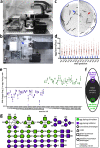Egg-laying and locomotory screens with C. elegans yield a nematode-selective small molecule stimulator of neurotransmitter release
- PMID: 36002479
- PMCID: PMC9402605
- DOI: 10.1038/s42003-022-03819-6
Egg-laying and locomotory screens with C. elegans yield a nematode-selective small molecule stimulator of neurotransmitter release
Abstract
Nematode parasites of humans, livestock and crops dramatically impact human health and welfare. Alarmingly, parasitic nematodes of animals have rapidly evolved resistance to anthelmintic drugs, and traditional nematicides that protect crops are facing increasing restrictions because of poor phylogenetic selectivity. Here, we exploit multiple motor outputs of the model nematode C. elegans towards nematicide discovery. This work yielded multiple compounds that selectively kill and/or immobilize diverse nematode parasites. We focus on one compound that induces violent convulsions and paralysis that we call nementin. We find that nementin stimulates neuronal dense core vesicle release, which in turn enhances cholinergic signaling. Consequently, nementin synergistically enhances the potency of widely-used non-selective acetylcholinesterase (AChE) inhibitors, but in a nematode-selective manner. Nementin therefore has the potential to reduce the environmental impact of toxic AChE inhibitors that are used to control nematode infections and infestations.
© 2022. The Author(s).
Conflict of interest statement
The authors declare the following competing interests: S.H., J.K., A.R.B., K-L.C., J.P., M.L. and P.J.R. have patents pending related to nementin; the remaining authors declare no competing interests. Mention of trade names or commercial products in this publication is solely for the purpose of providing specific information and does not imply recommendation or endorsement by the U.S. Department of Agriculture.
Figures






Similar articles
-
Deciphering the molecular determinants of cholinergic anthelmintic sensitivity in nematodes: When novel functional validation approaches highlight major differences between the model Caenorhabditis elegans and parasitic species.PLoS Pathog. 2018 May 2;14(5):e1006996. doi: 10.1371/journal.ppat.1006996. eCollection 2018 May. PLoS Pathog. 2018. PMID: 29719008 Free PMC article.
-
Anthelmintic drugs and nematicides: studies in Caenorhabditis elegans.WormBook. 2014 Dec 16:1-29. doi: 10.1895/wormbook.1.143.2. WormBook. 2014. PMID: 25517625 Free PMC article. Review.
-
Using C. elegans Forward and Reverse Genetics to Identify New Compounds with Anthelmintic Activity.PLoS Negl Trop Dis. 2016 Oct 18;10(10):e0005058. doi: 10.1371/journal.pntd.0005058. eCollection 2016 Oct. PLoS Negl Trop Dis. 2016. PMID: 27755544 Free PMC article.
-
Caenorhabditis elegans is a useful model for anthelmintic discovery.Nat Commun. 2015 Jun 25;6:7485. doi: 10.1038/ncomms8485. Nat Commun. 2015. PMID: 26108372 Free PMC article.
-
Monoaminergic signaling as a target for anthelmintic drug discovery: receptor conservation among the free-living and parasitic nematodes.Mol Biochem Parasitol. 2012 May;183(1):1-7. doi: 10.1016/j.molbiopara.2012.02.001. Epub 2012 Feb 11. Mol Biochem Parasitol. 2012. PMID: 22343182 Free PMC article. Review.
Cited by
-
Automated multimodal imaging of Caenorhabditis elegans behavior in multi-well plates.Genetics. 2024 Oct 3;228(4):iyae158. doi: 10.1093/genetics/iyae158. Online ahead of print. Genetics. 2024. PMID: 39358843
-
Antiaging Effect of 2-O-β-D-Glucopyranosyl Ascorbic Acid Derived from Lycium barbarum L. Through Modulating the IIS Pathway and Gut Microbiota in Caenorhabditis elegans.Foods. 2025 May 25;14(11):1875. doi: 10.3390/foods14111875. Foods. 2025. PMID: 40509403 Free PMC article.
-
Sensory modulation of neuropeptide signaling by CASY-1 gates cholinergic transmission at Caenorhabditis elegans neuromuscular junction.J Biosci. 2025;50:4. doi: 10.1007/s12038-024-00488-x. J Biosci. 2025. PMID: 39912398 Free PMC article.
-
Advances in Anthelmintic Target Identification.Int J Mol Sci. 2025 Apr 15;26(8):3738. doi: 10.3390/ijms26083738. Int J Mol Sci. 2025. PMID: 40332360 Free PMC article. Review.
-
Nemacol is a small molecule inhibitor of C. elegans vesicular acetylcholine transporter with anthelmintic potential.Nat Commun. 2023 Mar 31;14(1):1816. doi: 10.1038/s41467-023-37452-6. Nat Commun. 2023. PMID: 37002199 Free PMC article.
References
-
- Affairs, U. N. D. o. E. a. S. Consolidated Lst of Products Whose Consumption and / or Sale Have Been Banned, Withdrawn, Severely Restricted or Not Approved by Governments (New York, 2009).
Publication types
MeSH terms
Substances
Grants and funding
LinkOut - more resources
Full Text Sources
Miscellaneous

